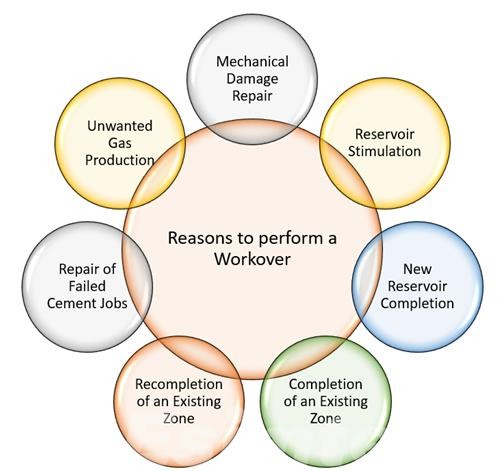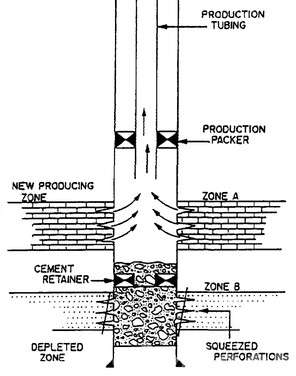What are the Different Types of Well Workover
Imagine a well as a long, intricate straw reaching deep underground to tap into a reservoir of oil and gas. Over time, this straw can become clogged, damaged, or simply less effective at drawing fluids. A well workover is akin to taking that straw out, giving it a thorough inspection and fix-up, and then putting it back in – only much more complex and sophisticated.
Unlike oil and gas drilling, which creates an entirely new wellbore, a well workover revisits an existing well to address various downhole issues. These interventions can be as straightforward as cleaning out accumulated gunk or as intricate as repairing a broken downhole pump or stimulating a sluggish reservoir. The overarching goal of a well workover is to improve or maintain wellbore functionality, ultimately translating to keeping oil and gas flowing efficiently.
The need for well workovers arises from the natural challenges associated with hydrocarbon production. As wells mature, several factors can lead to a decline in production:
- Formation Damage: Over time, the rock formations around the wellbore can become clogged with minerals, drilling fluids, or other debris, hindering the flow of oil and gas.
- Equipment Wear and Tear: Downhole pumps, valves, and other equipment are constantly under pressure and wear down over time, reducing their efficiency.
- Deposit Buildup: Paraffin wax, scale (mineral deposits), and other materials can accumulate within the wellbore, restricting flow and hindering production.
Well workovers play a critical role in mitigating these issues. By performing necessary maintenance, repairs, and enhancements, workovers can:
Restore well production to its former glory, or even surpass it through stimulation techniques.
Extend the productive life of a well, maximizing recoverable hydrocarbons.
Improve the overall efficiency and safety of well operations.
In essence, well workovers are like tune-ups for oil and gas wells. They are an essential part of a well’s lifecycle, ensuring continued productivity and economic viability.

Types of Well Workovers (by Objective)
Well workovers can be broadly categorized based on their primary objective. Here’s a more detailed look at the three main types:
Production Enhancement Workovers
These workovers aim to breathe new life into wells experiencing production decline. Here are some common procedures used to achieve this:
- Cleaning: Hydrocarbon production can be hindered by the buildup of various materials within the wellbore. Paraffin wax, a waxy substance found in crude oil, can solidify and restrict flow paths. Similarly, scale, a hard mineral deposit, can accumulate on tubing walls, reducing wellbore diameter. Workovers utilize tools and techniques like coiled tubing with cleaning jets or scraping tools to remove these blockages and restore flow efficiency.
- Equipment Repair/Replacement: Downhole equipment like rod pumps, gas lift systems, or electrical submersible pumps (ESPs) are crucial for lifting hydrocarbons to the surface. Over time, these components can wear out, malfunction, or become inefficient. Workovers involve retrieving the malfunctioning equipment, performing repairs on the surface if possible, or replacing them entirely with new units to restore well production.
- Stimulation: In some cases, the decline in production might be due to formation damage within the reservoir itself. This damage can occur due to various factors like drilling fluid invasion during well completion or the natural precipitation of minerals within the rock pores. Stimulation techniques like acidizing involve pumping acidic fluids into the formation to dissolve these damaging materials and enhance permeability, allowing hydrocarbons to flow more freely towards the wellbore. Hydraulic fracturing, another stimulation technique, utilizes high-pressure fluid to create fractures in the rock, increasing the overall surface area exposed to the wellbore and improving hydrocarbon flow.

Wellbore Maintenance Workovers
These workovers prioritize the structural integrity of the wellbore, ensuring safe and reliable production. Here are some key procedures involved:
- Leak Repair: Leaks in the well casing or tubing can compromise the entire wellbore’s integrity. These leaks can allow fluids to migrate between different formations, potentially causing environmental contamination or endangering groundwater resources. Workovers address these leaks by injecting special sealants or patching materials, or even replacing the damaged casing or tubing sections entirely.
- Component Replacement: Various downhole components like packers, which isolate zones within the wellbore, or flow control devices like sliding sleeves, can malfunction or deteriorate over time. These malfunctions can lead to production inefficiencies or even safety hazards. Workovers involve retrieving these components, replacing them with new ones, and ensuring proper functionality upon reinstallation.
- Wellbore Cleanout: Sand production, a natural phenomenon in some formations, can accumulate within the wellbore and restrict flow paths or damage downhole equipment. Additionally, scale buildup, as mentioned earlier, can also occur within the wellbore itself. Workovers utilize coiled tubing with cleaning tools or circulation techniques to remove this sand or debris, ensuring smooth flow and protecting downhole equipment.
Well Abandonment Workovers
When an oil or gas well reaches its economic limit and is no longer commercially viable, it needs to be properly abandoned to minimize environmental impact and ensure long-term safety. Well abandonment workovers involve a meticulous process:
- Zonal Isolation: The wellbore is strategically plugged with cement at various depths to isolate different producing zones. This prevents the migration of fluids between formations, protecting freshwater resources and preventing unwanted pressure imbalances.
- Equipment Retrieval: Any unnecessary equipment from the wellbore, like pumps, tubing, or packers, is carefully retrieved. This minimizes the amount of material left downhole, reducing the risk of corrosion or leaks in the future.
- Well Plugging: Permanent cement plugs are placed at strategic locations within the wellbore, typically near the surface and bottom of the well, to ensure the well is securely sealed and poses no environmental threat.
By understanding the different types of well workovers and their objectives, we can appreciate the importance of these interventions in maintaining wellbore health, optimizing production, and ensuring safe and environmentally responsible oil and gas operations.

Factors Influencing Workover Selection
Choosing the right type of well workover requires careful consideration of several key factors:
- Well History and Production Data: A thorough analysis of past production trends and wellbore data is critical. This analysis helps diagnose the root cause of the problem and identify the most suitable intervention. Production data may reveal a decline in flow rate, increased water cut (percentage of water produced with the oil/gas), or a buildup of pressure in the wellbore. Downhole pressure gauges and fluid sampling tools can provide valuable insights into the well’s condition.
- Reservoir Characteristics: The geology and properties of the producing formation play a significant role in selecting the most effective workover technique. Factors like reservoir pressure, permeability (ease of fluid flow through the rock), and the presence of natural fractures all influence the choice of intervention. For instance, a tight formation with low permeability might benefit from hydraulic fracturing, while a well suffering from paraffin buildup in the wellbore would require a cleaning operation.
- Economic Considerations: The cost-effectiveness of the workover needs to be carefully evaluated against the potential production gains. The cost of the operation will vary depending on the complexity of the procedure, the equipment required, and the rig time involved. Operators need to assess whether the expected increase in production will justify the investment in the workover.
- Regulatory Requirements: Environmental regulations and safety standards must be strictly adhered to during any well workover operation. Obtaining necessary permits and ensuring the workover plan complies with all relevant regulations is crucial. Additionally, utilizing environmentally friendly technologies and procedures for wellbore cleaning and stimulation is becoming increasingly important.
By carefully considering these factors, oil and gas producers can make informed decisions about the type of well workover needed to optimize well performance, maximize hydrocarbon recovery, and ensure safe and environmentally responsible operations.
Conclusion
Well workovers are vital procedures in oil and gas production, playing a crucial role in optimizing well performance, extending well life, and ensuring safe and environmentally friendly operations. By understanding the different types of well workovers and the factors influencing their selection, we can appreciate the importance of these interventions in maximizing hydrocarbon recovery. As technology continues to advance, well workover techniques are also evolving, offering more efficient and cost-effective solutions for maintaining and enhancing well productivity.

